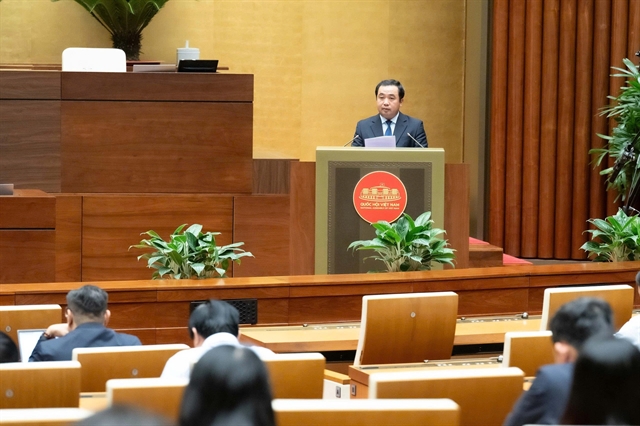 Society
Society

With forest coverage of nearly 51 per cent, the northern mountainous province of Lai Châu has been witnessing great benefits in terms of environment, water resources and people’s incomes.

|
| Farmers are taught to grow artichokes in Lùng Phinh Commune, Bắc Hà District in Lào Cai Province. — VNA/VNS Photo Quốc Khánh |
HÀ NỘI — With forest coverage of nearly 51 per cent, the northern mountainous province of Lai Châu has been witnessing great benefits in terms of environment, water resources and people’s incomes.
The province is also promoting the forest economy by focusing on growing trees with high economic value, such as rubber (13,000 ha), cinnamon (8,000 ha) and macadamia (over 5,000 ha). Many rare and valuable pharmaceutical products such as ginseng, Tam thất (Himalayan ginseng), and Hà thủ ô (Flowery knotweed) are also grown in the forest.
Giàng Páo Mỷ, Chairwoman of Lai Châu Provincial People's Council, said that the development of the forest economy in the northern midland and mountainous region, as well as in Lai Châu Province, was still modest compared to the potential and advantages of the region.
“The economic development under the forest canopy is very large. However, there is a shortage of an adequate legal corridor,” she said, adding that models of economic development under the forest canopy were still small in size and developed spontaneously.
“It’s difficult to trace the origin of the forestry products. The products have not been certified following national or international standards,” she said.
The local forestry industry still failed to attract many businesses to invest in the production, processing and consumption of such products. Most people do not yet have sustainable livelihoods with the exploitation of resources from the forest, Mỷ said.
Deputy Minister of Agriculture and Rural Development Phùng Đức Tiến said that forestry economic development in the northern midland and mountainous provinces in recent years has achieved many positive results.
The largest plantation timber area in Việt Nam was formed in the provinces of Tuyên Quang, Yên Bái, Phú Thọ and Quảng Ninh.
The region also sees areas for specialty forestry products such as the cinnamon forest in Yên Bái and Lào Cai, anise growing areas in Lạng Sơn and Quảng Ninh, medicinal herb growing areas in Yên Bái, Lào Cai, and Lai Châu.
Forest product processing zones have been formed in the provinces of Phú Thọ, Tuyên Quang and Yên Bái.
“With the diversity of forest resources, geography, climate, culture, the northern midland and mountainous provinces have great potential for economic development under the forest canopy such as timber and non-timber forest products supply, forest environmental service values include the provision of water regulation, biodiversity, carbon sequestration, ecotourism and resorts,” Tiến said.
“However, this potential has yet to be exploited in a multi-purpose direction,” he said.
Although the planted forest areas had large timber reserves, there are few deep processing establishments while logistics transportation costs remained high, thus reducing competitiveness.
Tiến said that due to the shortage of quality processing facilities, localities failed to develop typical products, refined products with high added value, but mainly raw products.
Tiến said that thanks to the policy of payment for forest environmental services, the northwest provinces such as Lai Châu, Điện Biên and Sơn La received large funds from hydroelectric power plants to protect natural forests. However, many other services have not been exploited, for example, water supply services, industrial water supply and CO2 absorption.
“The potential and multifaceted values of forests have not been fully exploited, especially products associated with cultural characteristics of ethnic minorities,” he said.
At the Conference on Economic Development under the forests of the Northern Midlands and Mountainous Provinces, organised by the Ministry of Agriculture and Rural Development (MARD) and the People's Committee of Lai Châu Province earlier this month, localities were concerned about the insufficient implementation of policies on the development of non-timber forest products under the forest canopy.
The achievements of science and technology have not been properly applied to modernise medicine production from herbal ingredients. There is no master plan to conserve and develop non-timber forest products.
Minister of Agriculture and Rural Development Lê Minh Hoan said that the ministry would pay more attention to solving institutional problems and develop a programme and projects on economic development under the forest canopy for the region.
Local resources, cultural values and creativity were three main pillars for agriculture development, not only production output, he said.
“It’s necessary to create more economic resources into a chain of goods, as well as combine eco-tourism and mountainous tourism to generate more income for people,” he said. — VNS
The northern midlands and mountainous region include 17 provinces with a forest area of about 5.5 million ha, accounting for 39.6 per cent of the total forest area of Việt Nam. The region’s natural forests are about 3.96 million ha, accounting for 38.6 per cent of the country’s natural forest area. The region’s planted forest area is nearly 1.8 million, equal to 40.8 per cent of the national planted forest area. According to the Ministry of Agriculture and Rural Development, the region has 747 enterprises specialising in producing, trading, processing wood and forest products. From 2011 to 2020, the region collected total revenue of more than VNĐ7.75 trillion (US$335.7 million) from forest environmental services. The region also has the potential to develop eco-tourism thanks to tourist attractions including Hoàng Liên National Park with Fansipan peak, Bái Tử Long National Park, Hạ Bay - a World Natural Heritage, Mường La, Tà Xùa, Sốp Cộp and Xuân Nha nature reserves in Sơn La province. Hundreds of thousands of tourists visit the destinations each year, spending an estimated VNĐ620 billion, which helped create jobs, improve people's income and add to the local budgets of the provinces. Besides providing timber and forest products, Việt Nam's eco-tourism is implementing four out of five types of forest environmental services. It is estimated that the service value of the forest ecosystem in 2020 was nearly VNĐ39 trillion, of which, VNĐ33.4 trillion from timber and non-timber products, VNĐ2.541 trillion from forest environment services, VNĐ975 billion from carbon sequestration and storage services and VNĐ2.02 trillion from ecotourism. — VNS |




